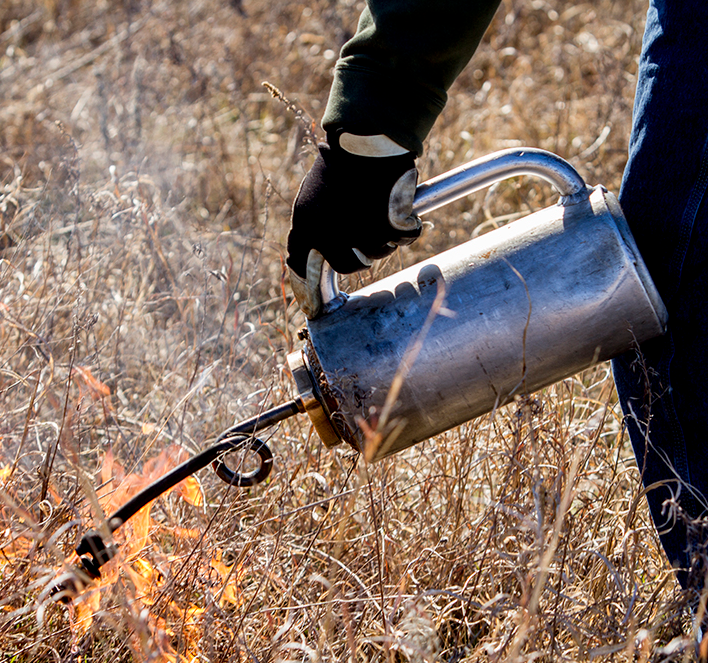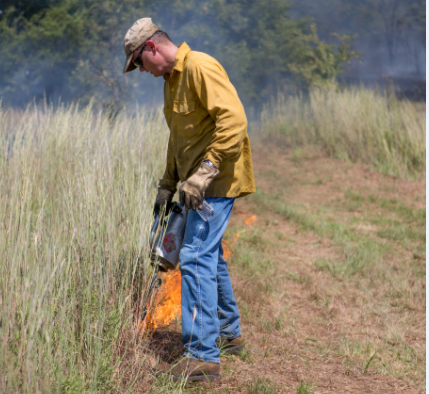The minimum equipment needed for every prescribed burn include ignition devices, fire suppression, communication, and personal safety apparel. Other equipment that can be helpful is drinking water, fuel containers, chainsaws, fence pliers, water hoses, axes, and weather instruments.
Ignition equipment
Matches or a lighter should be taken to every burn, whether for starting or fighting a fire (removing fuel is one of the most effective ways to stop a wildfire).

A drip torch probably is the most useful and widely used ignition tool on prescribed burns. Drip torch fuel typically is a mixture gasoline and diesel with 20-50 percent gasoline depending upon air temperature and fuel conditions. Additional pre-mixed drip torch fuel generally is brought to a burn in spark and rupture-resistant containers, which allows drip torches to be quickly refilled.
Other ground ignition devices include fusees or road flares, propane torch, terra torch , and delayed ground ignition devices. Large burns sometimes are ignited with aerial equipment such as a helitorch or delayed aerial ignition devices (DAIDS).
Fire suppression equipment

The most important fire suppression equipment is some type of water sprayer or pumper unit. All burns should have at least one power water sprayer present. Power sprayers can be traditional fire trucks, spray units mounted on skids, herbicide or livestock sprayers, ATV sprayers, etc. Spray units can be powered by gasoline motors, electric motors, or by power take-off (PTO) units. Power sprayers should be checked out, confirmed fully functional and filled with water prior to a burn. Spray units should always be started and left running so they are ready to use before the fire is ignited.
Other tools that can be useful for suppressing fire are: leaf blowers, rakes, swatters, and shovels. Leaf blowers can be used to extinguish fire in tree leaves or short grass, as well as mop-up along the edge of the fire line. Rakes also work well to extinguish low intensity fires and mop-up. Burning materials always should be blown or raked into the burned area.
Communication equipment
The fire boss should have a mobile telephone that can be used to call for assistance if problems develop. Where signal reception is adequate on larger burns, fire crews may use mobile telephones for internal communication. The best and most reliable communication equipment used by fire crews is two-way radios. Make sure the two-way radios provide adequate communication links on large burns where distance or topography interfere with signals.
Personal protective equipment

Every member of a burn crew should be dressed in clothing that is fire-resistant, including pants, shirts, jackets, boots, gloves, and hats. Clothing should be made of natural fibers such as 100% cotton or fire-resistant material like Nomex. Natural fibers do not burn or melt easily nor do specialized synthetic fire-resistant materials. Shirts should be long-sleeve and pants should be free from holes, rips or tears. Safety glasses or goggles are also very helpful to reduce heat on the face and protect the eyes from airborne particles. Apparel made from polyester and nylon, tennis shoes and open toe shoes are inappropriate for burns.
Other equipment
Drinking water is essential for most burns, and especially on growing season burns to keep the fire crew well hydrated. Spark and rupture-resistant containers with extra fuel for power sprayers, extra oil-fuel mix for leaf blowers or chainsaws are usually brought to a burn when their associated equipment is present. When burning in timber or near trees, chainsaws, pole saws, and or axes can be necessary to address burning snags or burning portions of live trees near firebreaks. Fencing pliers, wire cutters, or bolt cutters can be very helpful to quickly access a spot fire across a fence. Water hoses may be necessary to refill water tanks from the nearest available spigot. Weather meters, such as Kestrel pocket weather meters, can be useful to monitor actual, on-site weather conditions before, during, and post burn.
